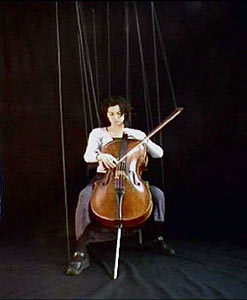
Born in 1973 in Luxembourg City (LU)
Lives and works in Luxembourg City (LU)

1999
Video, colour, sound
Durée : 1'44"
Year of Purchase: 2003
Above and beyond training to a high level as a cellist, it is perhaps the cultural melting-pot in which Su-Mei Tse has been immersed (born in cosmopolitan Luxembourg to Chinese and British parents) which has led her as a plastic artist to choose the question of the universal language that is music. Her whole œuvre is drawn to the musical motif, in all its metaphorical aspects, an elegant, precise work taking in films, photographs, performances, sculptures and installations. Paris road sweepers set in an artificial African desert, where the rhythmical movements recall battery ‘brushes’, an audio headset made out of two large shells, an egg-timer rotating on a powered disc: so many visual echoes inspired by sound paradigms. Temporality. Flux. Rhythm. Bars. Compositions. But far from being idealistic, these representations contradict the image of purity and harmony often stuck on this most abstract of the arts. In La Marionnette (2002, video loop), for example, the artist frantically plays the cello, her limbs connected to wires. In so doing, she embodies the classical allegory of the body as a mechanical and lifeless puppet subjected as a tragic figure of the human condition to an invisible but dominant manipulator. While the jerky script, the exaggerated gestures and the endless repetition of the shots give the scene a vaguely burlesque tone, the resulting dissonant noise rather displays a certain violence, as if the musical performer, like none other a prisoner of the conventions of their practice, represented the model par excellence of physical submission to the universal language of art. A grimacing, caustic reflection of the eurythmic ideal of great music. For, it turns out that the learning and practice of an instrument is nothing if not unnatural, and its demands come at a price. Intrinsically music may free the mind but it tames, wounds and bruises the body. Does not the sound in fact always come from the repercussions through space of a violent shock? Strings rubbed, hammered, plucked. Chords ‘struck’. From the same faltering perspective, the strange video Das Wohltemperierte Klavier (2001) shows fingers fitted with splints running over a piano keyboard. The apposition of these prostheses, referring to a handicap, to prevention, to the impossibility of any direct contact, adds further emotion to the stubbornness and determination to carry on playing, a survival of the need to communicate despite the pain. Without being too forceful or emphatic, but through a precise centring of straightforward situations, Su-Mei Tse more universally questions the notion of contrast and even rather, in a gentle way, of discordance. As with her mix offered to visitors of three teas of different origins, or her installation of two tuning forks at distinct frequencies, the artist works on a harmonic identity to be found between radically unassimilatable organic, material and cultural elements.
Guillaume Désanges